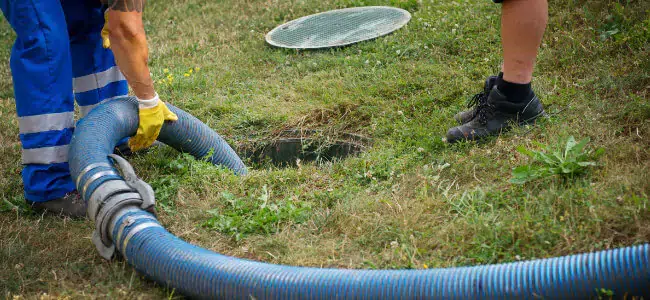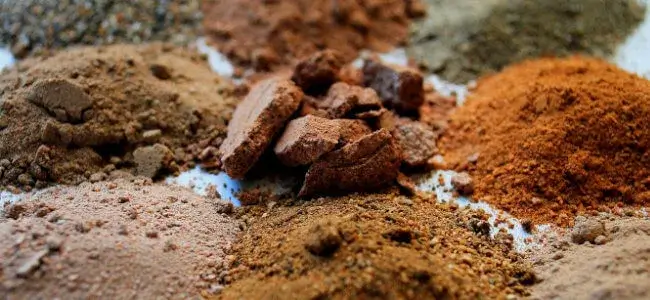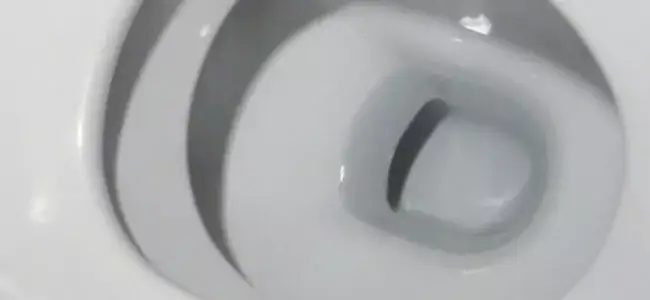Septic tank cleaning and pumping – Canadian septic owners guideline 2024

TABLE OF CONTENTS
Septic tank cleaning is the process of pumping your tank to ensure it is completely emptied of its solid and liquid contents. Cleaning your septic tank regularly will help to avoid excess scum and sludge accumulation to free up space for decantation. It also helps to remove inorganic waste which cannot be broken down by bacteria. Canadian law makes it mandatory to clean your septic tank every couple of years. The exact number of years will depend on your region or province. The cleaning of septic tanks should be left to qualified septic companies because septic tanks produce toxic gases that are a health hazard.
Note: It is safe to open the lids of your septic tank, as long as you are careful and wear gloves, but you should never enter the septic tank because it is full of hazardous gases.
What are septic services?
Before we delve into the nitty-gritty of septic tank cleaning, let’s first understand what septic services mean. Septic services refer to the services that are provided with septic companies for septic system owners. These services include:
- Septic tank installation
- Septic tank repair
- Septic tank cleaning
- Septic tank maintenance
In addition to these services, companies like Bio-Sol also provide biological solutions for repairing failed systems or maintaining them. Their products are made from enzymes and bacteria so they are septic safe.
Do septic tanks need to be cleaned out?
Canadian law makes it mandatory to clean your septic tank every couple of years. If you skip septic tank cleaning for too long, the septic system might fail and that would eventually clog up the system. If your drainfield clogs up, it might start leaking thereby polluting the environment. This can usually be fixed with biological additives. However, the government has legislation against septic systems that are causing pollution and if an inspector finds you culpable of pollution, they might recommend that you install a new system and that will cost you anything from $10,000-$40,000 depending on the type of septic system you use.
How often should you have your septic tank pumped?
You should clean your septic tank every 2-5 years depending on how many bedrooms you have in your house as well as the local regulations. Different provinces in Canada have different recommended pumping periods. The table below gives the exact schedule for each province.
| Province | Recommended Septic tank pumping frequency |
| Ontario | 2 years |
| Quebec | 2 years |
| Nova Scotia | 3-5 years |
| New Brunswick | 2-3 years |
| Manitoba | 3 years |
| British Columbia | 3-5 years |
| Prince Edward Island | 3 years |
| Saskatchewan | 2-3 years |
| Alberta | 3-5 years |
| Newfoundland and Labrador | 2-4 years |
The government is very keen on ensuring septic systems do not pollute the environment. This is the primary reason why it has imposed statutory limits on the pumping periods outlined above. There are three main ways the government regulates this:
- The municipality pumps the tanks as soon as the required pumping period reaches
- The individual is required by the municipality to pump and then send proof of pumping e.g. a receipt or an invoice
- An inspector regularly visits your premises and checks the sludge and scum levels to determine if or not your tank was pumped on schedule.
If the pumping company notices water flowing back into the tank from the drainfield during or after the pumping, it is an indicator that the drainfield is clogged up. In such a case, you should try a shock treatment to resolve the issue. Otherwise, the tank might get full again within a very short time.
What are the signs that your septic tank is full/due for pumping?
As a septic system owner, there are some important signs that will tell you if your septic tank is due for pumping. Here are some of the important signs to look out for.
It’s time – this might not necessarily be a sign but it is worth mentioning all the same. If you haven’t pumped your tank in the last 3-5 years, it is a good idea to schedule a septic tank cleaning. Pumping the tank every few years ensures the tank doesn’t get full because if it does, it might start backing up or leaking which ultimately leads to pollution of the environment. But before you schedule a pumping, you could do a scum and sludge level test first. This will help you to establish if your septic system is really full. You can find a simple DIY scum and sludge level test on this article.
Clogged drain field – a full septic tank can result in a clogged drainfield. There are many tell-tale signs that would point to a clogged drainfield. These include sluggish drains, small pools of water in your lawn, bad odors, high nitrate concentrations in drinking water, and grass becoming greener around the drainfield area than around other places on your property.
Sewage backup – when the septic tank gets full for whatever reasons, it will both overflow on the lawn and drain field area or it will back up into the house. A backup can also occur when there is too much scum which ends up blocking the inlet pipe in the tank. A sewage backup is not only annoying but also a serious health hazard and it should, therefore, be responded to promptly.
Pollution to the environment – Almost every septic system is strained from normal use – especially since most homeowners use substances that are toxic to bacteria. However, this can be easily corrected through shock treatment. Neglecting to do this can result in a system failure. A failed system will not only pollute the groundwater but the environment as well. It is mandatory to replace a septic system that is causing pollution to the environment.
How to clean a septic tank
Only duly registered and licensed septic tank cleaners should be allowed to pump your tank. Septic tanks emit hazardous gases so cleaning of the tank should be left to the pros. The first step in cleaning the septic tank is locating the septic tank. If you are not sure where the septic tank is located, the pumping contractor will do it for you. But finding the septic tank life shouldn’t be that hard. Here are some pointers that can help you identify where the septic tank is if the lids are not visible in your lawn.
Locate the septic tank
- Septic tanks are usually located away from the foundation of the house but adjacent to where the plumbing leaves the house.
- You can also use a probe bar to locate the tank although this should be avoided if your tank is made of polyethylene or fiberglass.
- You can also request for the on-site sewage plans for your house form the local authorities. They usually have them on file and these plans will pinpoint exactly where the septic tank is located on your property.
Start emptying
After locating the septic tank, the actual cleaning of the tank will commence. Cleaning of the septic tank must ensure that all the liquids and solids are emptied from the septic tank. To ensure the solids are emptied, the septic tank cleaning company will have to ensure the sludge and scum layers are disintegrated and mixed with the liquid. To do this, they will start by pumping some of the liquid out and then pumping it right back at the bottom of the tank. This disturbance will result in the breaking up of the sludge and scum layers. The hose might also be used to probe and break the solid layers into smaller particles. Once this is achieved, the contents of the tank can then be pumped out.
Look for potential issues
The septic tank cleaning company should inspect the system when cleaning it and take note of some important things including:
- If there are any signs of effluent on the property, especially around the septic tank and drain field.
- Signs of high liquid levels just before pumping or any past signs of high liquid levels. High liquid levels might indicate backups from the drain field.
- Backflow of liquids into the tank from the leach field as soon as the tank is pumped. If this happens, it could mean the drain field has failed
- Abnormally low liquid levels – if the liquid levels are low after normal usage of the septic tank for years, it could indicate there is a tank leakage
- The inflow of some groundwater into the septic tank as it is being pumped out
Taking note of the above things is quite important because it will help you know how healthy your septic system is and if you need to start thinking of septic system repair.
Once the septic tank has been successfully cleaned, the manhole cover should be carefully replaced and sealed. Any minor spillages that might have happened during the pumping process should be cleaned away with water but major spillages need to be disinfected, removed and buried. The Environmental Health Service should be notified in the event of any major spillages.
Which methods are used to clean a septic tank?
There are two main methods that are used by contractors when cleaning septic tanks – complete and selective emptying.
- Complete emptying: this is where the contractor completely removes all the contents of the septic tank. The contractor then transports the waste into a designated septic sludge treatment facility. Complete emptying of septic tanks is not recommended. Leaving a few inches of sludge at the bottom of the tank can help to restart the bacterial activity after pumping the tank. However, there are some situations where complete emptying might be ideal. These include holding tanks and cesspools.
- Selective emptying: as the name suggests, the goal of selective emptying is to ensure the tank is not left completely empty. Different contractors use different methods to achieve this. Some pump everything out of the tank then return some of the liquid into the tank. The pumped liquid is filtered first to ensure they only pump backwater that has a residual suspended matter concentration of not more than 350 mg/l. Selective emptying is considered a sustainable way of pumping the tank because it returns some of the bacteria right back into the tank and this enables the septic system to be efficient even after it has been pumped.
Where does the septic waste go after a tank cleaning?
The pumped septic waste should be disposed into public septage receiving facilities. The septic companies usually secure permission from these facilities in advance. If septic sludge is accidentally discharged on an unapproved site, the septic company should notify the environmental health office immediately. Any septic spillage of approximately 15 gallons in volume should not be cleared by the septic company without notifying the environmental health office. Septic tank sludge that has any hazardous material like chemicals, paints, solvents, etc. should be disposed of at Class 1 Disposal sites. This is because hazardous materials might interfere with the processes of wastewater treatment.
What options do I have if I can’t get a pumping truck to my septic tank location?
Island dwellers have unique challenges when it comes to waste disposal. Apart from the challenge of installing a septic system, there is also the issue of how to pump it. Vancouver and Montreal Islands and other large islands in Canada have septic companies that offer all septic services from septic tank installation to septic tank pumping. However, the smaller islands don’t have this option. The health department has a barge that goes around these tiny Islands to pump the septic tanks. This barge usually visits the tiny islands without septic services at least once a year. If you have a cabin in the woods, your options are limited. The good news is since the cabin septic system is not as heavily used as a typical domestic system, it will not fill up as quickly. You can make the system even more efficient by using shock treatment and upkeep products like the ones offered by Bio-Sol.
Is it possible to have a septic tank pumped during winter?
It is possible to pump your tank during winter but it is usually harder and more expensive. The complexity of pumping septic tanks in winter has little to do with the pumping equipment. The biggest problem is usually accessibility to your property and accessing the septic tank once the truck finally parks on your compound. If there is too much snow, shoveling might be required which complicates the process even further. But accessibility is not the only challenge during winter. Here are two other known septic challenges during winter.
Compacted snow – driving over the septic tank or drain field causes the soil and snow to compact. Under normal circumstances, snow provides good insulation and so the freezing temperatures do not affect the septic tank. However, the compacting of soil with the snow means the snow will no longer act as insulation to the soil and septic tank. This could result in the freezing of your tank. To avoid this, avoid driving or moving heavy machinery over your septic tank or drain field area.
Frozen tank components – Frozen tank components slow down the metabolic rates of the anaerobic bacteria which means the bacteria will not adequately break down the waste. Leaking cisterns and showerheads during winter should be fixed immediately. Water that moves through the plumping in small droplets could easily freeze in the pipes. To avoid frozen components, it is advisable to keep the system active by using water every day. As tempting as it may be, do not pour antifreeze because that will actually ruin the system by killing the helpful bacteria.
Because of the unique challenges septic systems face during winter, it is advisable to pump the tank just before the winter season kicks in. This is especially so if you notice the tank is almost full or if your tank has not been pumped for the last 3-5 years.
How much does it cost to pump a septic tank ?
How much you spend on pumping your septic tank will largely depend on the size of the septic tank. On average, pumping a 1200-1500 gallon tank will cost anything in the range of C$200-C$400. However, the prices may go higher than this depending on a number of variables. For instance, if your system requires pumping during winter, you will have to pay more than you would ordinarily pay during warmer months.
When contracting a company to clean your tank, make sure to understand what pricing model they use. Some use a fixed contract arrangement while others use an hourly rate. Generally speaking, pumping a tank should take anything from 2-5 hours depending on the size of the tank and equipment being used. You can use the hourly rate quoted by the contractor to guestimate how much it will cost to have the tank pumped.
Does the size of the tank matter when pumping it?
The main determinants of the frequency of pumping your tank are how much wastewater is sent to the tank from your house, the statutory limits for your region, and how big the tank is. Generally speaking, the smaller the tank is, the more times it will need to be pumped and vice versa. But in most cases, the size of the tank doesn’t matter because there is a recommended pumping period for every province in Canada (refer to the table above).
How biological additives optimize the tank and facilitate pumping
Biological additives can be used to rejuvenate and stimulate the growth of bacteria in the septic tank. These bacteria play a vital role in the health of a septic system. For starters, they help to increase the rate at which organic waste is broken down. This ensures that the septic tank doesn’t get full too quickly. Using additives also helps to facilitate the pumping of the septic tank. Because the organic waste will have been liquefied by the bacterial processes, pumping the tank will be cleaner and easier.
In an ideal scenario, a healthy septic system would naturally have enough bacteria for the breaking down of organic waste. Unfortunately, the bulk of septic system owners unknowingly use toxic substances that end up in the septic tank. This toxicity adversely reduces the bacteria population in the septic tank and the easiest way of solving this situation is using biological additives. Bio-Sol’s biological additives are made from enzymes and bacteria and they introduce billions of bacteria into the septic tank. You can, therefore, use them to rejuvenate your system and consequently optimize the digestion of organic waste in the tank.
Conclusion
You should inspect your tank regularly and also have it pumped as is recommended by the provincial regulations to ensure it does not fail. If a septic tank fails, it will start leaking and such leakages pollute the environment. The law is very strict on this and it will require you to replace a septic system that has failed to the point of polluting the environment. It is therefore in your best interest to ensure you know your recommended pumping schedule. The schedule is determined by the provincial statutory regulations as discussed above.
OUR LATEST BLOG POSTS

Strange facts about septic systems
If you are a septic system owner, you might have heard all manner of myths. For instance, there is a common myth that throwing a dead cat in the septic tank can help rejuvenate bacteria and thereby make the septic tank more effective. But is this even true? In this article, we will not only answer that […]

Soils types and their impact on septic systems
SOILS TYPES AND THEIR IMPACT ON SEPTIC SYSTEMS However good your septic system is, it depends on the right soil type to complete the process of purifying the wastewater from your home. The soil type in the drainfield area will determine how well the effluent is filtered and if the water that is sent back to the […]

Avoid flushing these if you have a septic tank
Most homeowners wrongfully assume that their toilet can serve as some sort of garbage disposal. As a result, they end up flushing all manner of things in the toilets. Some of the things that are flushed down the toilet are actually innocent mistakes because homeowners think that is the right way to dispose of the products while in other cases, it is just a don’t care attitude. Whichever the case may be, flushing some of these things can result in septic system failure and it could cost you a fortune. We have rounded up some of the commonly-flushed products that you should never flush if you have a septic system.
PERFECT! I WOULD NEED...
Discover which products are the best for your needs!You can contact us at 1-800-378-6132 (toll free) or click on the following button to access our free online evaluation.
GET A QUOTE ONLINELog in to your account
Whoops! It happens sometimes...
CREATE A NEW ACCOUNT
CONGRATS!
You are now registered and ready to go. You can add and change any of your information on your client profile.
Unfortunately, we do not ship our products to the USA at the moment.
But, if you live in the United States and would like to order them, please fill in the form below. You will then be notified as soon as they are available in your country.
Thank you for your understanding!
Malheureusement, nous n’expédions pas nos produits en France pour le moment.
Mais, si vous êtes résident français et aimeriez les commander, remplissez s’il vous plaît le formulaire ci-dessous. Nous pourrons ainsi vous aviser aussitôt qu’ils seront disponibles dans votre pays.
Merci de votre compréhension!

-
30 products to avoid
-
What to replace them with
-
And everything you should know about your septic system
DOWNLOAD THIS FREE EBOOK!
Which email address should we send it to?


